Picture this: It’s a Saturday morning, and you’re sipping coffee, scrolling through homes on Zillow—not because you’re moving, but because, well, who isn’t a little Zillow-curious these days? Whether you’re a first-time buyer, a seasoned investor, or just daydreaming about that mid-century modern with the pool, Zillow has become the default window into America’s real estate soul. But behind every “just looking” session is a tidal wave of data shaping how homes are bought, sold, and rented in 2025.
As someone who’s spent years building SaaS and AI tools for business users (and, let’s be honest, doing my fair share of Zillow window shopping), I’m fascinated by how Zillow’s statistics don’t just reflect the housing market—they actively shape it. So, let’s dig into the numbers, trends, and insights that define Zillow’s role in the real estate ecosystem this year. Whether you’re in sales, marketing, tech, or just want to sound smart at your next dinner party, this is your data-driven guide to Zillow in 2025.
Zillow by the Numbers: 2025 Headline Stats
Let’s kick things off with a rapid-fire rundown of the most jaw-dropping Zillow statistics for 2025. These aren’t just numbers—they’re the pulse of the U.S. housing market:
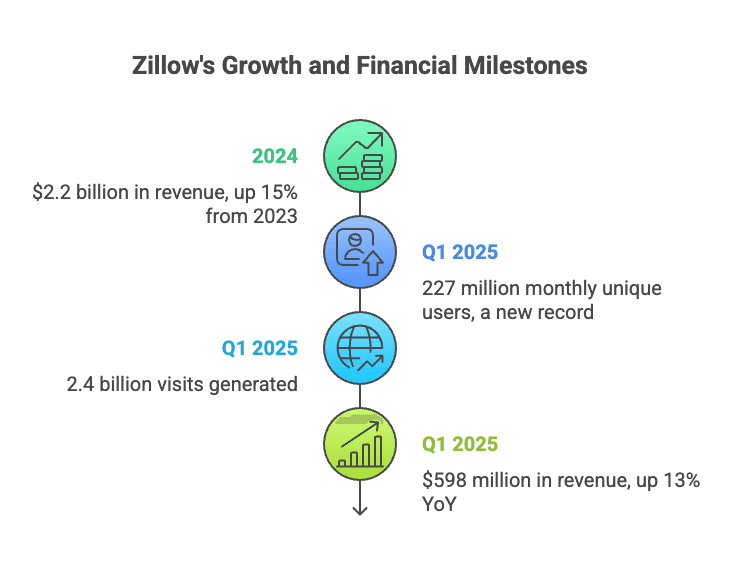
- 227 million monthly unique users on Zillow Group’s platforms in Q1 2025—a new record, up 5% year-over-year ().
- 2.4 billion visits generated in just one quarter ().
- Over 50% of all real estate portal visits in the U.S. go to Zillow—more than double the next competitor ().
- $2.2 billion in revenue for 2024, up 15% from 2023 ().
- $598 million in Q1 2025 revenue (up 13% YoY), with profitability on the rise ().
- Record-high 46 million renter households using Zillow to find homes ().
- Zestimate median error for on-market homes: ~1.9%—that’s some serious algorithmic flex ().
- Typical U.S. home value (ZHVI): $368,000 as of mid-2025 ().
- National rent index (ZORI): $2,049/month, with rent growth cooling to ~3–4% annually ().
If you’re a numbers person, you’re probably already thinking: “Wow, Zillow isn’t just a website—it’s the real estate market’s main stage.” And if you’re not a numbers person, don’t worry—I’ll translate all this into real-world impact as we go.
Zillow’s User Base: Who’s Searching for Homes in 2025?
Zillow’s reach in 2025 is, frankly, mind-boggling. After a slight dip in 2023, the platform is back to setting records, with 227 million monthly unique users in Q1 2025 (). That’s nearly 70% of the entire U.S. population—if you count every man, woman, child, and probably a few very savvy pets.
Who Are Zillow’s Users?
Zillow’s audience is a melting pot of America’s housing market:
- Renters: The unsung heroes of Zillow. There are about three times as many “renter movers” each year as home buyers, and renters are highly active on the platform (). With 46 million renter households in 2025, Zillow is their go-to for finding apartments and houses ().
- Buyers & Sellers: In 2024, an estimated 4 million “active shoppers” hunted for homes on Zillow (), and the platform facilitated over 1.4 million buyer connections through its Premier Agent network ().
- Investors & Landlords: They’re using Zillow’s data (Zestimates, rent prices, etc.) to inform deals and manage properties.
Demographics: The Faces Behind the Clicks
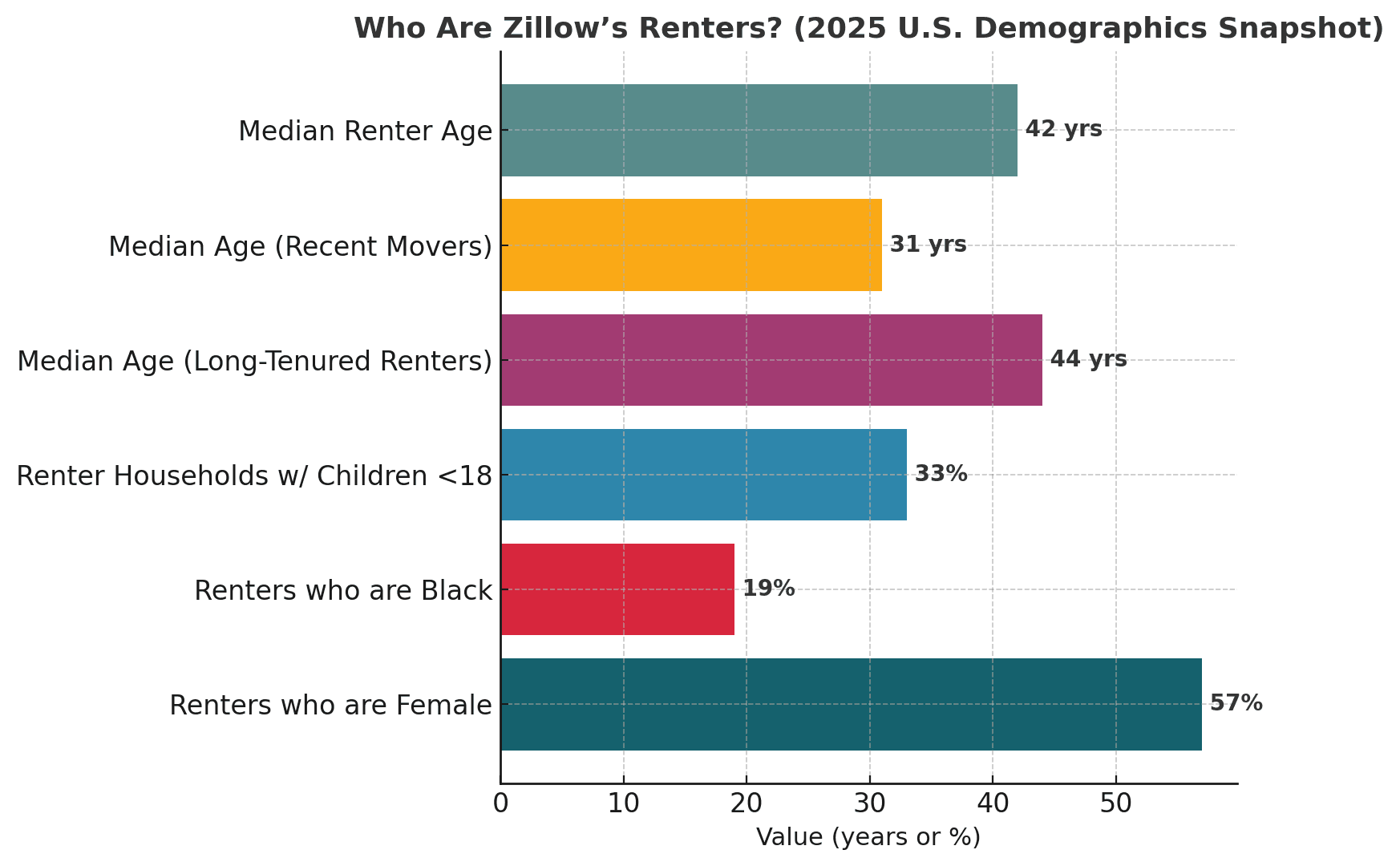
- Median renter age: 42 (but recent movers are even younger—median age 31) ().
- Families: About one-third of renter households have children under 18 ().
- Older adults: Long-tenured renters have a median age of 44, and many homeowners in their 50s–60s use Zillow to monitor the market or consider downsizing.
- Diversity: ~19% of Zillow renters are Black (vs. 12% of U.S. adults), and 57% of renters are female ().
How Are People Using Zillow?
It’s not just casual browsing. Zillow’s 80% direct or organic traffic means people are coming back, again and again, to check Zestimates, track price changes, and explore neighborhoods (). In fact, 72% of all home buyers used a Zillow Group site in 2023, and about a third connected with a Premier Agent ().
Zillow’s Reach vs. Competitors
Let’s put Zillow’s dominance in perspective:
| Platform | Avg. Monthly Visits (2024) | Market Share vs. Zillow | Avg. Visit Duration |
|---|---|---|---|
| Zillow.com | 366 million | 100% (the benchmark) | ~5:51 |
| Realtor.com | 142 million | ~39% | ~5:30 |
| Redfin.com | 108 million | ~30% | ~4:13 |
| Homes.com | 46.8 million | ~13% | ~3:25 |
()
Zillow’s traffic is more than the next three sites combined. Even as upstarts like double their traffic, Zillow remains the site to beat (). It’s like showing up to a 5K and realizing Zillow’s already finished the marathon.
Zillow Revenue: How the Real Estate Giant Makes Money
Zillow’s business model has evolved a lot—remember when they tried iBuying and lost nearly $900 million? Yeah, they’d rather you didn’t. Fast-forward to 2025, and Zillow is a leaner, meaner, more profitable machine.
Revenue Breakdown (2024–2025)
- Total 2024 revenue: $2.2 billion, up 15% from 2023 ().
- Q1 2025 revenue: $598 million, up 13% YoY ().
- Profitability: Adjusted EBITDA margin hit 26% in Q1 2025 (), and the company is guiding for continued profit growth.
Revenue Segments
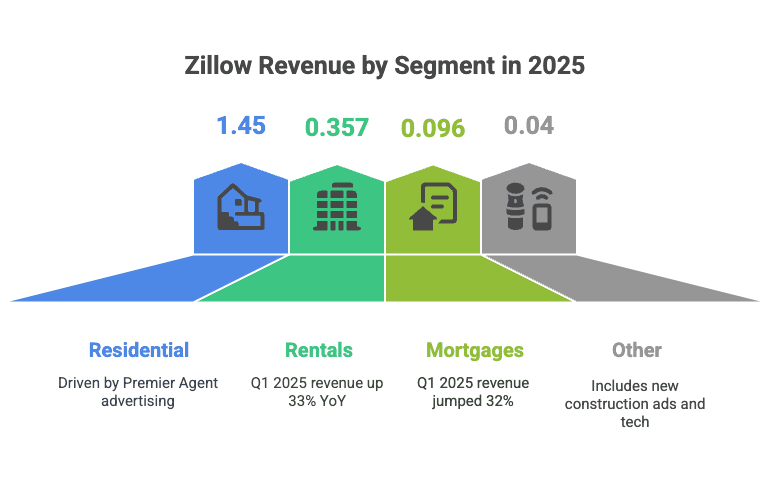
- Residential (“For Sale”): $1.45 billion in 2023 (~75% of total), driven mainly by Premier Agent advertising and related services ().
- Rentals: $357 million in 2023 (~18%), with Q1 2025 rentals revenue up 33% YoY ().
- Mortgages: $96 million in 2023 (~5%), but growing fast—Q1 2025 mortgage revenue jumped 32% ().
- Other: ~$40 million (new construction ads, tech, etc.).
Zillow’s revenue is now outpacing the housing market’s growth—a sign it’s monetizing more per transaction and gaining share of industry spend ().
Advertising & Lead Generation: The Engine Behind Zillow’s Growth
If you’re a real estate agent, Zillow’s Premier Agent program is probably as familiar as your morning coffee. Agents pay to feature their profiles and receive leads in chosen ZIP codes. The scale is wild:
- 1.4 million+ buyers connected via Premier Agent in 2021—likely higher now ().
- Every ~4 seconds, a homebuyer is connected with a Premier Agent ().
- Agents using Premier Agent close 60% more transactions on average ().
- Premier Agent revenue: $1.45 billion in 2023, about 75% of total revenue ().
Flex Model
Zillow’s Flex program lets agents pay only when they close a deal with a Zillow lead—a “you eat what you kill” approach. The fee? Recently raised from 35% to 40% in several markets (). Flex now accounts for about 25% of Premier Agent revenue.
Agent ROI
- Cost per lead: ~$139 in smaller markets, $200+ in major metros ().
- Top agents spend $1,000–$3,000+ per month on Zillow ads ().
- 84,000+ agent advertisers (with a focus on top-producing teams) ().
Agents grumble about the fees, but Zillow’s audience is so massive that “not advertising on Zillow” is like not bringing business cards to a networking event. Risky move.
Zillow and the Real Estate Market: Trends & Insights for 2025
Zillow isn’t just a mirror for the housing market—it’s more like the weather channel, stock ticker, and Magic 8 Ball rolled into one (minus the vague answers). Its forecasts and data shape expectations for buyers, sellers, and the industry at large.
2025 Market Trends: What Zillow Is Seeing
- Home sales: Projected at 4.14 million existing home sales in 2025, up 1.9% from 2024 ().
- Home prices: After a bullish start to the year, Zillow now expects a ~1.4% drop in home values over 2025—essentially flat movement ().
- Inventory: Supply is finally rising, with about 1.24 million homes on the market (still 26% below pre-2019 norms, but improving) ().
- Mortgage rates: Hovering around 7%, with hopes they’ll dip into the mid-6% or high-5% range by year-end ().
- Affordability: The typical mortgage payment has doubled since 2019, keeping many buyers on the sidelines ().
Regional Variations
Zillow’s data shows big differences by metro. For example, Hartford (+7.5% YoY) and Cleveland (+7.2%) led the nation in rent growth in late 2024, while Sunbelt markets like Austin saw flat or declining rents ().
Price Cuts
A fun stat for bargain hunters: 23% of listings had a price reduction in January 2025—the highest January rate since 2018 ().
Zillow Rent Estimate: Shaping the Rental Market
If you’re a renter or landlord, Zillow’s Rent Zestimate and ZORI (Zillow Observed Rent Index) are now industry benchmarks.
- Rent Zestimates: Cover over 100 million homes, with a median error of 5–10% (pretty solid for a free tool) ().
- National ZORI: $2,049/month as of May 2025 ().
- Rent growth: Cooling to ~3–4% annually, down from double-digit surges during the pandemic ().
Rental Market Trends: From Affordability to “Renter Nation”
- Record-high 46 million renter households—that’s about 36% of all U.S. households ().
- Demographic shifts: More families and older adults are renting. One-third of renter households have kids under 18, and 24% of renters are Baby Boomers ().
- Affordability: Median U.S. renter spends ~30% of income on rent, but in expensive metros it’s 40%+ ().
- Concessions: 1 in 3 rental listings offered a concession (like a free month) in early 2025 ().
- Long-term renting: More people are renting for longer, and single-family home rentals (often owned by investors) have risen 40% since 2020 ().
The upshot? Renting is no longer just a “young person’s phase”—it’s a long-term reality for millions, and Zillow is the platform of choice for navigating it.
Zillow’s Market Position: Strengths, Weaknesses, and What’s Next
Let’s break down Zillow’s competitive position with a classic SWOT analysis (don’t worry, I’ll keep the MBA jargon to a minimum):
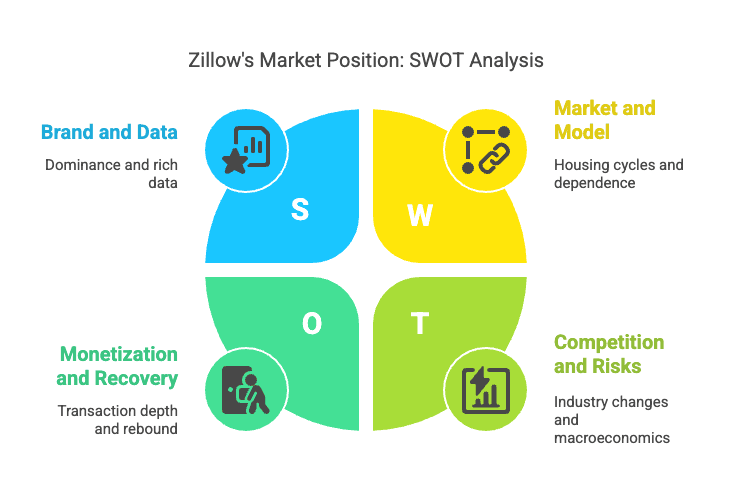
Strengths
- Unmatched scale: #1 in real estate web traffic, with 227 million+ monthly users ().
- Brand dominance: “Zillow” is basically a verb now.
- Rich data & tech: Zestimates, ZHVI, ZORI—these are industry standards.
- Premier Agent marketplace: Owns the agent advertising market, with robust revenue and pricing power ().
- Strong financials: Cash-rich, low debt, and improving profitability ().
- Product ecosystem: Building a “housing super app” that integrates home search, financing, renting, and more.
Weaknesses
- Tied to housing cycles: When home sales drop, so does Zillow’s growth ().
- Premier Agent dependence: Still heavily reliant on agent advertising.
- Zestimate accuracy perception: Despite improvements, high-profile errors can dent trust ().
- Past missteps: The iBuying flop is still a cautionary tale ().
Opportunities
- Deeper transaction monetization: Mortgages, rentals, new construction, and more ().
- Rentals: A $25B+ total addressable market ().
- New tech & data products: More B2B services, APIs, and integrations.
- Market recovery: When home sales rebound, Zillow stands to gain disproportionately.
Threats
- Competition: CoStar’s is coming on strong, and aren’t going away ().
- Industry changes: Commission lawsuits, MLS rule changes, and the rise of exclusive listings could shake up the Premier Agent model ().
- Macroeconomic risks: High rates, low inventory, or a recession could slow growth.
- Agent pushback: If fees rise too much, agents may seek alternatives ().
Zillow Statistics in Context: What They Mean for Buyers, Sellers, and Investors
Zillow’s data isn’t just for real estate nerds (though, full disclosure, I’m definitely one of those). Here’s how different audiences are using Zillow in 2025:
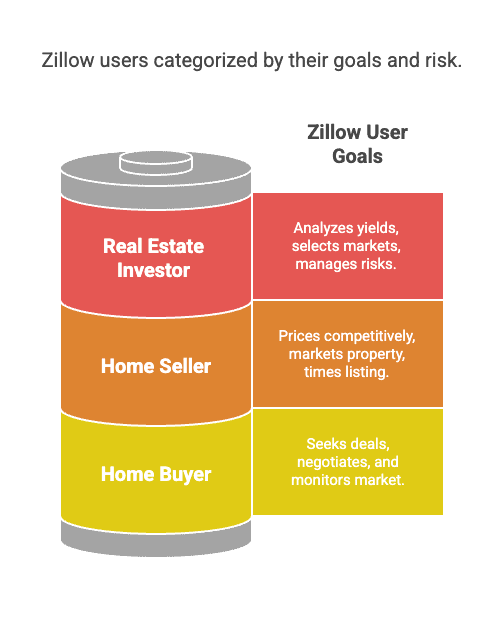
Buyers
- Market timing: Tracking price cuts, inventory, and mortgage rates to decide when to buy ().
- Negotiation: Using Zestimates and listing history to make informed offers.
- Alerts: Staying ahead of new listings and price changes.
Sellers
- Pricing: Starting with their Zestimate, then adjusting based on local comps and market trends.
- Marketing: Leveraging Zillow’s listing tools, 3D tours, and analytics to attract buyers.
- Timing: Listing earlier in the year to avoid potential price declines.
Investors
- Yield analysis: Comparing ZHVI and ZORI across cities to spot opportunities.
- Market selection: Using rent and home value trends to decide where to buy, flip, or hold.
- Risk management: Watching for signs of cooling markets or rising concessions.
Zillow’s transparency has leveled the playing field—what used to be insider info is now in everyone’s pocket. In fact, the Federal Reserve uses Zillow’s rent index as a real-time inflation indicator (). That’s a long way from “just a listings site.”
The Takeaway: Key Zillow Statistics to Watch in 2025
Let’s wrap up with the stats and trends that matter most as the real estate market continues to evolve:
- User base: 227 million monthly uniques and counting—Zillow’s audience is the market.
- Revenue: $2.2 billion in 2024, with double-digit growth and rising profitability.
- Market share: Over 50% of all real estate portal visits, dwarfing the competition.
- Home values: ZHVI at $368,000, with prices expected to dip ~1% in 2025.
- Rent trends: National ZORI at $2,049/month, rent growth cooling to 3–4%.
- Affordability: 30% of renter income goes to rent, with six-figure incomes needed in many cities.
- Premier Agent: Still the cash cow, but Flex and new products are diversifying revenue.
- Threats: Watch for competition from , industry rule changes, and macroeconomic headwinds.
If you’re in sales, marketing, tech, or e-commerce, these numbers are more than trivia—they’re signals for where the market (and your business) is headed. And if you’re just here for the Zillow daydreams, hey, I get it. But now you can impress your friends with some serious real estate stats next time you’re scrolling through listings.
Want More Data-Driven Insights?
If you’re as obsessed with data as I am, check out more content, like our deep dive on or our guide to . And if you’re looking to automate your own data workflows, give a spin—our AI web scraper is built for business users who want to turn web data into actionable insights (and maybe spend a little less time scrolling Zillow… or not, I won’t judge).